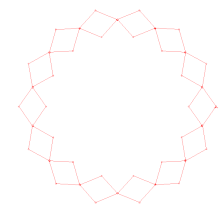Hoberman mechanism
A Hoberman mechanism is a deployable mechanism that allows circumferential actuation to generate radial motion. The kinematic theory behind the Hoberman mechanism has found application in creating deployable structures for space.[1][2] The mechanism has one degree of freedom. However, in case of singularity it can gain extra degrees of freedom.

Animation of a two-dimensional Hoberman mechanism
A everyday example of this is the Hoberman sphere.[3] Other examples of ways he has used the mechanism are:[4]
- A two person tent that pops open and snaps shut
- A stadium dome that dilates like a pupil
- A briefcase that folds down to a book
- medical instruments that expand and contract
Also see
gollark: I wonder how well-cited that Wikipedia article is.
gollark: They aren't very good weapons for anything but warcrime maximization.
gollark: The police need *orbital bombardment*, obviously.
gollark: In what way?
gollark: Technically, with some ridiculous and implausible amount of resources and control of some of the internet and some broadcasters, you could totally fake this, for a while.
References
- Faist, Katherine A.; Wiens, Gloria J. (2010). "Parametric study on the use of Hoberman mechanisms for reconfigurable antenna and solar arrays". 2010 IEEE Aerospace Conference. pp. 1–8. doi:10.1109/AERO.2010.5446956. ISBN 978-1-4244-3887-7.
- http://www.google.co.in/patents/US5024031
- https://en.wikipedia.org/wiki/Hoberman_sphere. Missing or empty
|title=(help) - "Transformer".
This article is issued from Wikipedia. The text is licensed under Creative Commons - Attribution - Sharealike. Additional terms may apply for the media files.